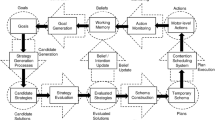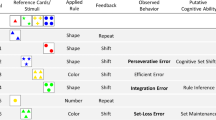Conclusions
-
1.
From the results of the tests described we may conclude that a type of patient diagnosed as dementia præcox shows the difference in behavior previously described. The difference between the schizophrenic patients studied and normal individuals lies in the capacity for abstract behavior. Both the normal and abnormal show concrete behavior in certain situations where concrete behavior is adequate. In the sorting tests, the normal may not seem to differ from the abnormal as long as it is possible to perform a task successfully in a concrete way, but the normal individual is also able to sort in another, more abstract way which the abnormal cannot do. The abnormal proceeds in a concrete way on all sorting tests. Thus, the characteristic defect of the schizophrenic patients studied was an impairment of the capacity for the type of behavior we call “abstract behavior.”
-
2.
The tests applied in this investigation allow a differentiation between the capacity for abstract and concrete behavior. Performance on these tests allow judgment of whether the patient is able to proceed only in a concrete way or to proceed in both an abstract and a concrete way. Such judgment is reached by using tests made up of steps which demand more or less abstract behavior on the part of the patient.
Similar content being viewed by others
References
Bolles, M. M.: The basis of pertinence. Arch. Psychol., 1937, 212: 1–51
Goldstein, K.: Der Aufbau des Organismus. Martinus Nijhoff, Haag, 1934, p. 363.
Goldstein, K.: The problem of the meaning of words based on the observations of aphasic patients. J. Psychol., 1936, 2: 301–316.
Goldstein, K. and Gelb, A.: Über Farbennamenamnesie nebst Bermerkungen über das Wesen der amnestischen Aphasie. Psycholog. Forsch., 1924, 6: 127–166.
Goldstein, K. and Katz, S. E.: The psychopathology of Pick's disease Arch. Neurol. and Psychiat., 1937, 38: 473–490.
Hanfmann, E. and Kasanin, J.: A method for the study of concept formation. J. Psychol., 1937, 3: 521–540.
Pintner, R. and Paterson, D. G.: A Scale of Performance Tests. D. Appleton and Co., New York, 1931, p 218.
Rothmann, E.: Untersuchung Eines Falles von unschriebener Hirnschädigung mit Storungen auf verschiedensten Leistungsgebieten. Schweiz. Arch. f. Neurol. u. Psychiat., 1934, 33: 35–70.
Vigotsky, L. S.: (Translated by J. Kasanin.) Thought in schizophrenia. Arch. Neurol. and Psychiat., 1934, 31: 1063–1077.
Weigl, E.: Zur psychologie sogenannter Abstraktionsprozesse. I. Untersuchen über das ‘Ordnen’. Z. Psychol., 1927, 103: 2–45.
Author information
Authors and Affiliations
Additional information
The authors are indebted to Dr. Carney Landis of the New York Psychiatric Institute for his advice and cooperation in this investigation, and also to the members, of the staffs of Rockland State Hospital and the Psychiatric Institute for making this study possible.
Rights and permissions
About this article
Cite this article
Bolles, M., Goldstein, K. A study of the impairment of “abstract behavior” in schizophrenic patients. Psych Quar 12, 42–65 (1938). https://doi.org/10.1007/BF01563129
Issue Date:
DOI: https://doi.org/10.1007/BF01563129




